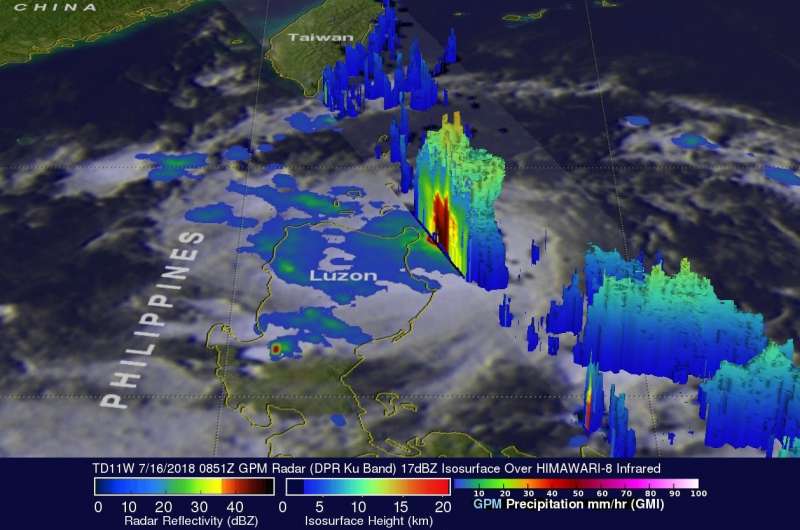GPM satellite sees Tropical Cyclone Son-Tinh dropping rain in the Philippines

As Tropical Depression 11W was strengthening into Tropical Storm Son-tinh near the northern Philippines, the Global Precipitation Measurement mission or GPM core satellite analyzed its rainfall.
TD11W or Son-Tinh, is the first tropical cyclone of 2018 for the northern Philippines, where the storm is known locally as "Tropical Cyclone Henry."
At the time GPM passed overhead, Son-Tinh was still a tropical depression. It was close to the northern Philippines on July 16, 2018 at 4:51 a.m. EDT (0851 UTC). GPM is a joint mission between NASA and the Japan Aerospace Exploration Agency, JAXA.
Data collected by GPM's Microwave Imager (GMI) and Dual-Frequency Precipitation Radar (DPR) instruments showed that the tropical cyclone was relatively small but was dropping moderate to heavy rain over much of the northern Philippine island of Luzon.
GPM's radar (DPR Ku Band) also showed that convective storms within the tropical cyclone were producing extremely heavy precipitation in the Philippine Sea near the northeastern tip of Luzon. GPM's radar (DPR Ku Band) scans of these powerful storm showed that rain there was coming down at a rate of greater than 165 mm (6.5 inches) per hour.
GPM's radar data (DPR Ku Band) were used to create a 3-D cross-section image through TD11W's precipitation. The images showed that extremely intense downpours were returning radar reflectivity values exceeding 59 dBZ to the GPM satellite. These probes of TD11W's precipitation by the satellite's radar showed that a small cluster of powerful storms were reaching heights above 15.2 km (9.4 miles).
At 11 a.m. EDT (1500 UTC) the Joint Typhoon Warning Center or JTWC noted that Son-Tinh was located near 19.1 degrees north latitude and 112.4 degrees east longitude. That's about 197 nautical miles south-southwest of Hong Kong. Son-Tinh has tracked westward at 22 knots (25 mph/40 kph). Maximum sustained winds were near 40 knots (46 mph/74 kph).
The Joint Typhoon Warning Center (JTWC) predicts that TD11W will move west-northwestward and become a tropical storm over the South China Sea. The JTWC expects it to approach Hainan in the western South China Sea.
Provided by NASA's Goddard Space Flight Center



















